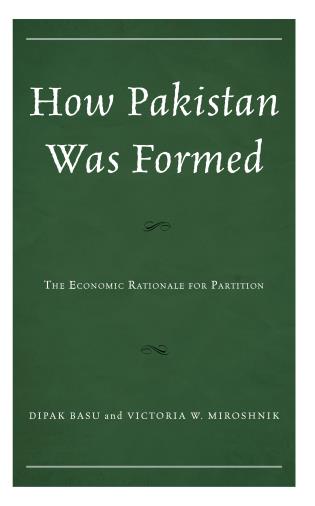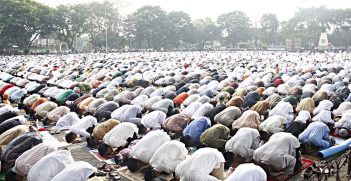Book Review: How Pakistan Was Formed: The Economic Rationale for Partition

The contested history of the partition of India, and ultimately Pakistan’s formation, is divulged in this book. Issues arise from the authors’ alignment with the Hindutva cause.
Several recent historical events have sparked contentious reinterpretations aligned with political and ideological agendas. Turkish historians, for instance, contest the Armenian genocide, while Pakistan’s official history dismisses the alleged military atrocities during Bangladesh’s independence as isolated incidents.
The partition of India in 1947 is highly susceptible to such reinterpretation for two reasons. Firstly, the enormous scale of atrocities directly affected a substantial portion of the sub-continental population, leading to an unconscious desire to create narratives that soothe individual and collective egos. Secondly, influential groups on both sides of the India-Pakistan border aim to undo the partition and may construct narratives to achieve this goal, even if it means radically reshaping historical accounts.
Dipak Basu and Victoria Miroshnik’s recent book How Pakistan Was Formed: The Economic Rationale for Partition exemplifies ideologically motivated historiography. Relying on secondary data and selective literature, it advocates for a South Asian confederation. The book includes nine chapters, presenting the following six core arguments.
First, during their long rule over India, the Muslim invaders engaged in plunder, imposing discriminatory taxation and socio-political structures. They also targeted Indian civilization, destroying universities and cultural symbols to undermine the Hindu faith. Similarly, the British rule over India involved ruthless pillage, resulting in significant deindustrialisation. Once a major contributor to the global economy, India was reduced to one of the world’s poorest regions. The British extraction of wealth from India through heavy taxation and exploitative trade played a vital role in capital formation for Britain’s industrial development during the 19th century.
Secondly, British rule impacted local communities differently. Hindus were well-positioned to capitalise on the business opportunities created by colonial trade and enthusiastically embraced Western education. In contrast, Muslims were averse to modern education and struggled to engage effectively in the emerging modern economy, hindered by institutions unsuitable for establishing large, enduring enterprises capable of efficient resource reallocation.
However, the Muslims did not face economic disadvantages nor the prospect of economic domination by Hindus following partition. They held a significant presence in the military and, although underrepresented in civilian government services, this was due to their educated elite’s preference for migrating to princely states, where they held a considerable share of government employment. The Muslim claim that partition was necessary to protect them from economic exploitation and cultural domination by the Hindu majority lacked foundation.
Thirdly, the authors contend that the true reason for partition was the British desire to establish a strategic foothold to counter Soviet expansion into South Asia and the Persian Gulf. This objective was driven by the need to safeguard oil fields in the Middle East and maintain control over air and sea routes to Australia after India departed from British rule.
To fulfil their strategic objective, the British enlisted Muhammad Ali Jinnah to establish a separate country. Jinnah willingly embraced this plan as it aligned with his ambition of attaining authority over a part of India, recognising that he could never hold power over the entire country. However, pursuing this ambition led him to commit what the authors deem “crimes against humanity.” The authors accuse him of being responsible for the deaths, dishonour, and impoverishment of millions of non-Muslims in 1947.
Similarly, the authors claim that the British recruited Mahatma Gandhi in 1914-15 and systematically promoted him to further their cause. They criticise him for allegedly taking no action to protect Hindus from widespread rape and murder during the partition. They argue that it was mainly due to Gandhi’s lack of interest in including certain regions, such as Eastern Bengal and Baluchistan, in future India, facilitating the loss of these areas.
Fourthly, the authors assert that most rapes and murders during partition were perpetrated by Muslims. The carnage began with the Muslim League’s announcement of Direct Action Day in 1946, resulting in over 7,000 Hindus killed in Calcutta alone. As the partition date approached in mid-1947, violence erupted in Rawalpindi and other cities of what is now Pakistan. The authors suggest that the scale of violence against women was immense, with an estimated 83,000 women abducted by Muslims. Furthermore, they point out that Muslim League leaders, including Jinnah, took no action to stop or condemn the violence that occurred during the partition. Although violence also occurred in several cities in what is now India, the authors characterise it as defensive and on a much smaller scale.
Fifthly, according to the authors, the underlying issue between India, Pakistan, and Bangladesh stems from the incomplete transfer of population. The population exchange widely anticipated during the partition remained incomplete. While most Hindus migrated to India, tens of millions of Muslims stayed in India. The authors argue that resolving regional tensions would be facilitated if these remaining Muslims could relocate to their new Muslim homelands.
Finally, the authors propose that since partition was unnatural and unnecessary, lacking substantial economic or cultural justifications, it should be partially undone by creating a confederation of South Asian countries with unrestricted movement for people.
The arguments put forth by the authors align closely with the Hindutva cause, which seeks to establish India as a Hindu-dominant nation. These arguments assert that India belongs exclusively to Hindus, while other religious groups, particularly Muslims, should emigrate to the countries designated for them.
The authors’ approach to pursuing the Hindutva cause appears to lack objectivity and thorough substantiation of their statements with evidence. They make serious allegations against prominent historical figures and present an alternative account of historical events without providing concrete evidence to support their claims. Consequently, their assertions remain mere conjectures rather than well-supported arguments.
The central argument of the book, that partition was a British scheme and that the British recruited figures like Jinnah and Gandhi to serve this purpose, is a clear example of the authors’ conjectural approach. Instead of presenting evidence on these individuals’ alleged recruitment as agents, they selectively quote other authors’ statements to support their claims but ignore the extensive body of literature that presents contrasting perspectives on the matter. This approach raises concerns about objectivity in their work.
This forsaking of objectivity is also evident in the one-sided portrayal of the horrors of communal violence during partition. The authors consistently highlight the murders and rapes committed by Muslims while downplaying similar atrocities against Muslims. Even when discussing a notable case of organised violence by a communal force known as the Bharat Jatia Bahini, the authors emphasise the force’s purportedly gentlemanly conduct as they “never touched the Muslim women and children or the aged and the infirm [while] all Muslim League thugs who had participated in the pogrom against Hindus and Sikhs were identified, hunted down, and killed.”
In summary, the book fails to adequately explore the economic rationale for partition and lacks a compelling explanation for the violent separation of Hindus and Muslims who had historically coexisted for centuries. The arguments presented are often one-sided and lack objective evidence to support their claims. Furthermore, the authors’ pursuit of the Hindutva cause undermines objectivity and raises concerns about the credibility of their assertions.
This is a review of Dipak Basu and Victoria W. Miroshnik, How Pakistan Was Formed: The Economic Rationale for Partition (Lexington Books, 2023). ISBN: 978-1-66691-744-4.
Muhammad Ahsan Rana is an Associate Professor of Social Policy and Agricultural Policy at Lahore University of Management Sciences.
This review article is published under a Creative Commons License and may be republished with attribution.





